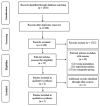Comparison of Muscle Strength, Aerobic Capacity and Body Composition between Healthy Adolescents and Those Living with HIV: A Systematic Review and Meta-Analysis
- PMID: 34073166
- PMCID: PMC8198095
- DOI: 10.3390/ijerph18115675
Comparison of Muscle Strength, Aerobic Capacity and Body Composition between Healthy Adolescents and Those Living with HIV: A Systematic Review and Meta-Analysis
Abstract
Background: The adverse effects of antiretroviral therapy associated with complications generated by human immunodeficiency virus (HIV) promote impairments in physical fitness in adolescents. Objective: To analyze the aerobic capacity, muscle strength, and body composition of adolescents living with HIV compared with a healthy population of the same age. Methods: Searches were performed in the MEDLINE, Embase, Web of Science, Scopus and SportDiscus databases until September 2019 and updated in April 2020. Eligibility Criteria: adolescents of both sexes in the age group from 10 to 19 years; living with HIV; cross-sectional, case-control, cohort studies; comparing with a healthy population. Mean differences and 95% Confidence intervals (CIs) were calculated using RevMan (software for systematic reviews). Results: Five articles were included, involving 197 adolescents living with HIV (16 to 18 years) and 185 without infection (13 to 18 years), with the sample in each study ranging from 15 to 65 adolescents. Aerobic capacity and muscle strength were reduced in adolescents with HIV, and body mass index was also significantly lower in this group. Conclusion: Adolescents living with HIV have impaired cardiorespiratory fitness, muscle strength, and body composition when compared to their uninfected peers. However, this systematic review provides limited evidence on the differences between the physical fitness outcomes of adolescents living with HIV compared to healthy adolescents.
Keywords: adolescents; cardiorespiratory fitness; child health; human immunodeficiency virus; physical fitness.
Conflict of interest statement
The authors declare no conflict of interest.
Figures
Similar articles
-
Progressive resistive exercise interventions for adults living with HIV/AIDS.Cochrane Database Syst Rev. 2004 Oct 18;(4):CD004248. doi: 10.1002/14651858.CD004248.pub2. Cochrane Database Syst Rev. 2004. PMID: 15495092
-
Aerobic exercise interventions for adults living with HIV/AIDS.Cochrane Database Syst Rev. 2005 Apr 18;(2):CD001796. doi: 10.1002/14651858.CD001796.pub2. Cochrane Database Syst Rev. 2005. Update in: Cochrane Database Syst Rev. 2010 Aug 04;(8):CD001796. doi: 10.1002/14651858.CD001796.pub3. PMID: 15846623 Updated.
-
Interventions for promoting habitual exercise in people living with and beyond cancer.Cochrane Database Syst Rev. 2018 Sep 19;9(9):CD010192. doi: 10.1002/14651858.CD010192.pub3. Cochrane Database Syst Rev. 2018. PMID: 30229557 Free PMC article.
-
School-based physical activity programs for promoting physical activity and fitness in children and adolescents aged 6 to 18.Cochrane Database Syst Rev. 2021 Sep 23;9(9):CD007651. doi: 10.1002/14651858.CD007651.pub3. Cochrane Database Syst Rev. 2021. PMID: 34555181 Free PMC article.
-
Antiretroviral post-exposure prophylaxis (PEP) for occupational HIV exposure.Cochrane Database Syst Rev. 2007 Jan 24;2007(1):CD002835. doi: 10.1002/14651858.CD002835.pub3. Cochrane Database Syst Rev. 2007. PMID: 17253483 Free PMC article.
Cited by
-
Cardiorespiratory fitness and health in children and adolescents: an overview of systematic reviews with meta-analyses representing over 125 000 observations covering 33 health-related outcomes.Br J Sports Med. 2025 Jun 3;59(12):856-865. doi: 10.1136/bjsports-2024-109184. Br J Sports Med. 2025. PMID: 40101938 Free PMC article.
-
Special Issue on Health, Physical Activity, and Performance in Youth.Int J Environ Res Public Health. 2021 Aug 26;18(17):8975. doi: 10.3390/ijerph18178975. Int J Environ Res Public Health. 2021. PMID: 34501565 Free PMC article.
-
Influence of Healthy Habits Counseling on Biochemical and Metabolic Parameters in Children and Adolescents with HIV: Longitudinal Study.Nutrients. 2021 Sep 17;13(9):3237. doi: 10.3390/nu13093237. Nutrients. 2021. PMID: 34579114 Free PMC article.
-
Health-Related Physical Fitness Evaluation in HIV-Diagnosed Children and Adolescents: A Scoping Review.Int J Environ Res Public Health. 2024 Apr 25;21(5):541. doi: 10.3390/ijerph21050541. Int J Environ Res Public Health. 2024. PMID: 38791753 Free PMC article.
-
Body composition, physical fitness and physical activity in Mozambican children and adolescents living with HIV.PLoS One. 2022 Oct 20;17(10):e0275963. doi: 10.1371/journal.pone.0275963. eCollection 2022. PLoS One. 2022. PMID: 36264880 Free PMC article.
References
-
- Ssebunya R.N., Wanyenze R.K., Namale L., Lukolyo H., Kisitu G.P., Nahirya-Ntege P., Kekitiinwa A. Prevalence and correlates of HIV testing among adolescents 10–19 years in a post-conflict pastoralist community of Karamoja region, Uganda. BMC Public Health. 2018;18:612. doi: 10.1186/s12889-018-5544-0. - DOI - PMC - PubMed
-
- Da Brasil S.M., de V em Saúde S. Boletim Epidemiológico HIV AIDS 2018. Ministério da Saúde; Brasília, Brazil: 2017. Departamento de Vigilância do HIV/Aids e das Hepatites Virais P e C das IST.
-
- Dos Reis L.C., De Carvalho Rondó P.H., de Sousa Marques H.H., Segri N.J. Anthropometry and body composition of vertically HIV-infected children and adolescents under therapy with and without protease inhibitors. Public Health Nutr. 2015;18:1255–1261. doi: 10.1017/S1368980014001591. - DOI - PMC - PubMed
Publication types
MeSH terms
LinkOut - more resources
Full Text Sources
Medical
Miscellaneous


